|
|
| Разместил (Author): |
SergUA6  |
| Авторские права |
© http://www.radioscanner.ru |
|
|
Текст
|
Analysis.
Basic methods and concepts
I am not think to raise the analysis in the sphere of art, but like any business it requires constant practice, finding out of not obvious solutions, the abilitys to squeeze out all of the available tools and even more.
The analysis is difficult to formalize but, nevertheless, if you stick to the common line of it’s realization, you can greatly reduce the spend time and save efforts. As already mentioned, the analyst works with the record, and the quality of the recording plays almost a fundamental role.
The absolute error that the analyst is a wizard who will classify any record of any quality. The chief cook can’t cook something tasty from rotten products doesn’t matter how hard he was trying :-).
Recording
Main requirements to the record
Record should be done only in a pure Microsoft PCM WAV format, with digit capacity not below 16bit per sample.
No any of recorders, tape recorders, cellular telephones, microphones should be used.
It is possible to understand the scout in a camp of the enemy with a microphone-button and a dictaphone, but I do not understand the person sitting in the apartment, having near at hand PC and making records on the dictaphone, or through a microphone, having leant it to the receiving set, it’s simply waste of time.
The extremely painful problem is the quality of used receivers for record of the signals.
Unfortunately, very small amount of receivers can provide really good recording quality, from the point of view for the analyst. The main problem is that any ALC systems can’t be disabled.
The purpose of the standard ALC system is to provide constant level of the signal on the output of the receiver when level of the signal is changing on an input.
However standard ALC systems do not do distinctions between a signal and noise, do not distinguish signals on sorts of modulation and, as consequence, make the records of little use for the analysis. Besides, even modern SDR hardware-software complexes do not provide necessary quality in most cases. The reason is that nobody interested in the principle, saving of the signal “as is”, nobody with the exception of the analysts. The situation is gradually changing for the better though, more people are beginning to understand and realize the problem.
Another problem is not serious approach to recording, it is widely believed that if the wiring is connected, program of the record is launched and you are done.
It is not so, the program should be customized and adjusted with the signal’s source, it is necessary to install the record level, to select the frequency of discretization, the file format and to make sure that there are no overloads and etc.,
The first and mandatory step at the analysis of any record is the estimation of the quality of the current record. I will especially underline, it’s not intended an absence of the noise and complete ideality of the material, no. The unique aim is to make sure that nothing unnecessary and strange has got into the record, that there are no overloads and no artifacts, that record was not edited/corrected and its possible to start studying. I underline again, the estimation quality of record - is the first and necessary step in the signals analysis.
Firstly form of the signal is checked in the WF module for the purpose of:
1) overloads
2) granulation, caused by 8-bit character set, or other reasons
3) distortion of the positive and negative half-waves
4) displacement relative to zero
5) factors of ALC or any another a bad things work.
Several examples
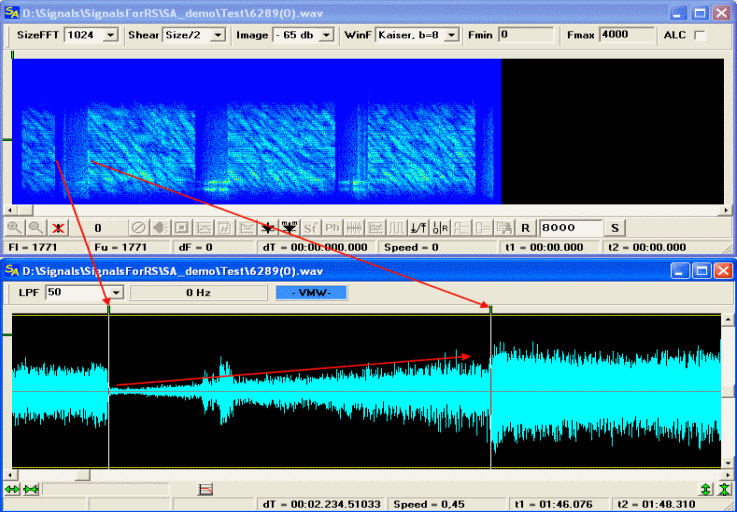
As we see ALC does work here 100%, and it is perfectly visible as noise rises on the signal’s level. Besides, the signal itself is a subject to strong selective fading (that is already complicates the analysis), but also ALC does add some problems by "aligning" all of this with an unknown methods. And there is more to come.
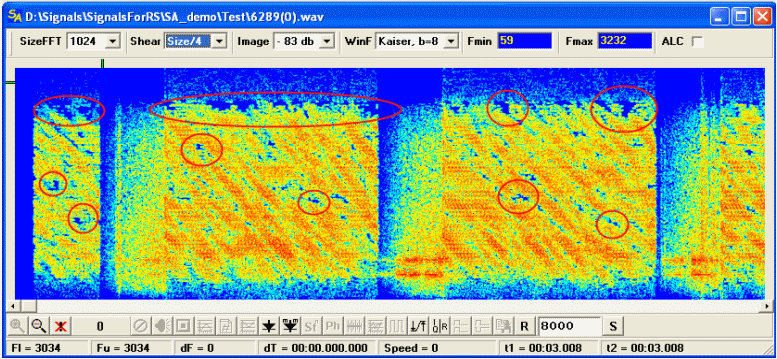
Such signal’s fallouts (loss) to zero are very characteristic for various systems of the compression that means the signal hasn’t been written in pure PCM format, so in this case we can’t speak about effective analysis. You can analyze, such records, of course, but you can’t guarantee anything. In such situations I say: Record is not liquid(illiquid).
So popular SDR receivers, are so inspire their owners with confidence in superiority, what to convince them that «not all is smooth in a kingdom”, will cost hard efforts. And the problem is not so much in the receivers, but in the software which is written for them. Speed of processing is often reached by quality loss, but who sees it?
The typical example:
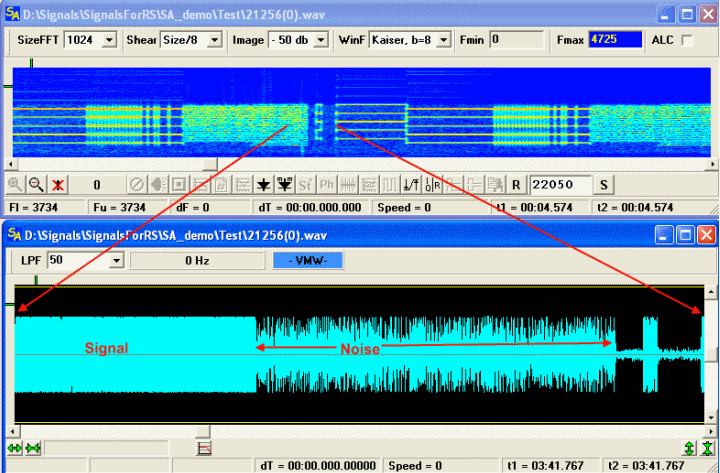
The very hard ALC is used at program SSB demodulation. So it doesn’t matter how beautifully the signal looks, distortions are unavoidable. Besides, processing of the continuous data flow is not qualitatively fulfilled.
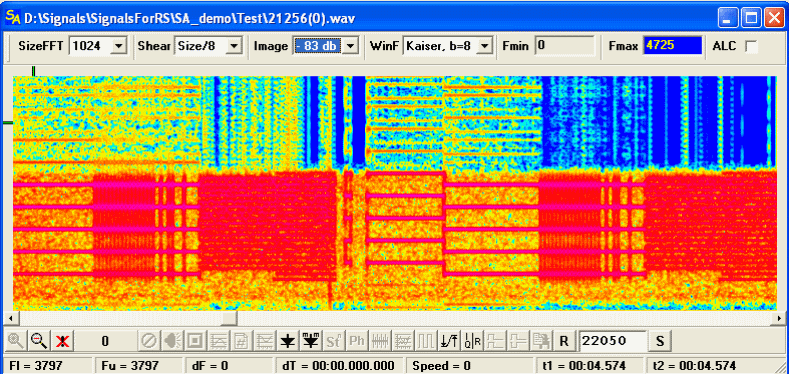
Probably, it will seem unessential to someone, but the level of this dirt/noise approximately ~60 dB, and it is the digit (DSP), which defeats analogue and guarantees quality, where is that quality? Why it is needed artificially to complicate the analysis which is the very difficult task already? There are examples of the quite good SDR software. Besides, the signal is cut off(non-liquid).
Another problem is the decorating of the signal. I do not know what motivates people, when they do it. One thing, you erase the signal, for placing it in the database, where the task of the analysis is not needed, and quite another, when you give the *decorated* signal and appeal for help to understand(analyze) it. The artificial example, but in practice happen very often.
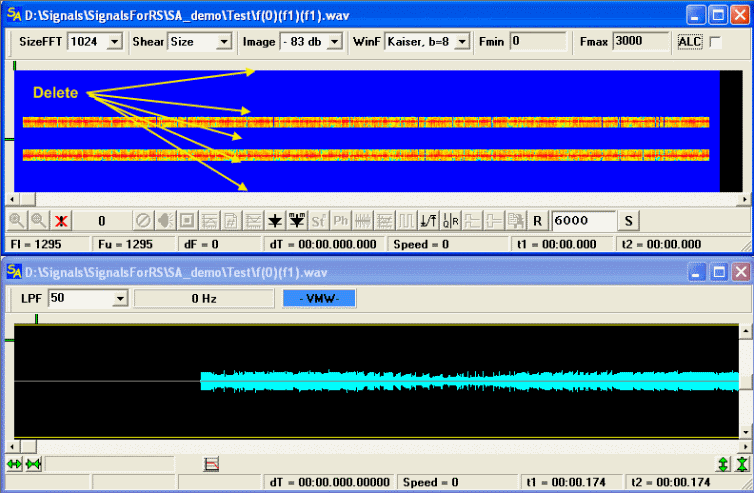
In my point of view, it is illiquid signal. Do not do anything with the record, give it to the analyst, he will understand that is necessary and what is not. I will not stay long on the problem of the signal’s quality, but once again remind you, this is the first and mandatory step.
next...
|
|
|
|
Добавлять комментарии могут только зарегистрированные, активировавшие регистрацию и не ограниченные в доступе участники сайта!
|
| Файл создан: 18 Apr 2009 01:15, посл. исправление: 21 Apr 2009 23:45 |
|

